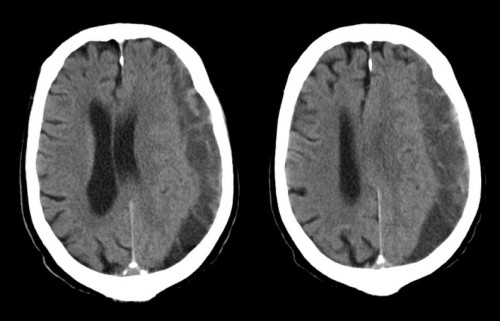Subdural Hematoma

I am often asked what are the most common problems that a Neurosurgeon sees in the Emergency Room. Given that Neurosurgeons see such a wide spectrum of patients with many different diagnoses, I thought the readers of Golden Life might be interested in one of the most common Neurosurgical emergencies that affects senior citizens: Subdural Hematoma.
The covering of the brain is called the dura. Blood clots can form between this covering (the dura) and the brain. We call this type of blood clot a “subdural hematoma.” Seniors are particularly susceptible to forming a subdural hematoma for several reasons.
As we age we certainly are not as agile and athletic as in our youth. Seniors by and large are more likely to lose their balance and fall, striking their head. Head trauma is the most common cause of subdural hematoma. In the elderly even incidental trauma can lead to a subdural hematoma.
Because heart disease, peripheral artery disease, and stroke are so common, many older people are on blood thinners such as Coumadin, Plavix, and Aspirin. Although these medicines save lives, they unfortunately can increase the severity of bleeding after even minor head trauma, making a subdural hematoma even worse.
A well, our brains normally will decrease in size slightly as we age. Sometimes shrinkage or atrophy of the brain is a sign of dementia. More often it is just the normal aging of the brain and not associated with loss of cognitive ability. With atrophy, however, the space between the brain and its covering (the subdural space) increases in size.
There are small veins normally found within the subdural space that can become stretched as the brain atrophies with age. With head trauma these veins can tear and cause bleeding, leading to an acute subdural hematoma. If this hematoma becomes large enough it causes pressure on the brain. This can lead to confusion, weakness, even death.
Sometimes head trauma can cause these veins to tear but lead to a smaller hemorrhage or cause the injured vein to leak slowly over time. Or a larger hemorrhage may not completely dissolve and as the blood products break down over several weeks or even months, more fluid can collect over the surface of the brain. We call this a chronic subdural hematoma.
Patients with a chronic subdural hematoma often present with a progressive change in their mental capacities with confusion, loss of memory, difficulty concentrating or loss of other routine cognitive abilities. Many times patients with chronic subdural hematomas can have difficulty with their balance or even weakness on one side of their bodies. Other potential symptoms include difficulty with speech, headache, drowsiness, and seizures. If left untreated, a chronic subdural hematoma can cause death.
Since the symptoms of chronic subdural can include a slow loss of mental functions, patients with chronic subdural hematomas can sometimes falsely be labeled as having dementia or Alzheimer’s disease. Some patients with chronic subdural hematomas do not even remember hitting their heads. That is why it is so important for any patient with a change in mental status to undergo either a CT scan or MRI of the brain.
Many times a subdural hematoma will need surgery. If caught in time, it can be removed quite successfully and patients can return to most normal activities.
So seniors-- stay active but be safe. And wear your helmet when riding a bicycle around the neighborhood!
© Florence Neurosurgery and Spine Center